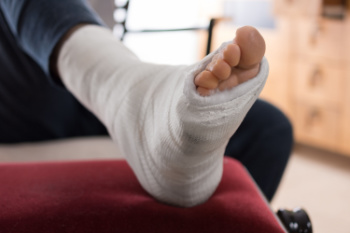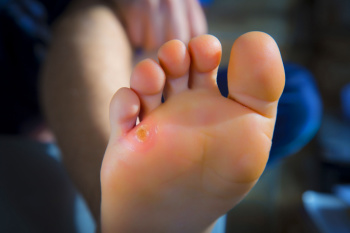Items filtered by date: September 2025
Acute Metatarsal Fractures and Proper Aftercare

A metatarsal fracture is a break in one of the long bones of the foot that connect the midfoot to the toes. Acute fractures often occur suddenly from trauma, such as dropping a heavy object on the foot, twisting an ankle, or experiencing a direct impact during sports. Symptoms may include immediate pain, swelling, bruising, and difficulty bearing weight. Proper diagnosis through imaging is essential to determine the severity and whether the fracture is displaced. Treatment may involve rest, immobilization with a cast or boot, and, in some cases, surgical fixation, where metal pins, screws, or plates are used to stabilize the bone. Aftercare is vital to ensure proper healing. This stage may include gradual weight bearing, targeted exercises, and supportive footwear to restore strength and mobility while preventing future injury. If you suspect a metatarsal fracture, it is suggested that you seek prompt evaluation and follow up care with a podiatrist for optimal recovery.
A broken foot requires immediate medical attention and treatment. If you need your feet checked, contact Joseph M. LaCava, DPM from Arkansas. Our doctor can provide the care you need to keep you pain-free and on your feet.
Broken Foot Causes, Symptoms, and Treatment
A broken foot is caused by one of the bones in the foot typically breaking when bended, crushed, or stretched beyond its natural capabilities. Usually the location of the fracture indicates how the break occurred, whether it was through an object, fall, or any other type of injury.
Common Symptoms of Broken Feet:
- Bruising
- Pain
- Redness
- Swelling
- Blue in color
- Numbness
- Cold
- Misshapen
- Cuts
- Deformities
Those that suspect they have a broken foot shoot seek urgent medical attention where a medical professional could diagnose the severity.
Treatment for broken bones varies depending on the cause, severity and location. Some will require the use of splints, casts or crutches while others could even involve surgery to repair the broken bones. Personal care includes the use of ice and keeping the foot stabilized and elevated.
If you have any questions, please feel free to contact our office located in Hot Springs, AR . We offer the newest diagnostic and treatment technologies for all your foot care needs.
Corns and Calluses on the Feet Explained

Corns and calluses are common foot problems, but they are not the same condition. A corn is a small area of thickened skin that often develops on the tops or sides of toes where friction or pressure is highest. Corns may be hard or soft, and can become painful when pressed. Calluses, on the other hand, are broader areas of thickened skin that usually form on the bottom of the foot, particularly on the heel or ball. They develop as the skin’s way of protecting itself from repeated pressure or rubbing. Wearing ill fitting shoes, foot deformities, or frequent standing and walking may contribute to both conditions. While they are often harmless, discomfort can interfere with daily activity. If you are experiencing painful corns or calluses, it is suggested that you visit a podiatrist for safe and effective treatment options.
If you have any concerns regarding your feet and ankles, contact Joseph M. LaCava, DPM of Arkansas. Our doctor will treat your foot and ankle needs.
Corns: What Are They? and How Do You Get Rid of Them?
Corns can be described as areas of the skin that have thickened to the point of becoming painful or irritating. They are often layers and layers of the skin that have become dry and rough, and are normally smaller than calluses.
Ways to Prevent Corns
There are many ways to get rid of painful corns such as wearing:
- Well-fitting socks
- Comfortable shoes that are not tight around your foot
- Shoes that offer support
Treating Corns
Treatment of corns involves removing the dead skin that has built up in the specific area of the foot. Consult with Our doctor to determine the best treatment option for your case of corns.
If you have any questions, please feel free to contact our office located in Hot Springs, AR . We offer the newest diagnostic and treatment technologies for all your foot care needs.
Top 5 Benefits of Custom Orthotics

Discover the long-term benefits of orthotics! Tailored to your unique foot structure, Custom Orthotics ensure every step radiates comfort and helps reduce foot and heel pain. Beyond comfort, they enhance your posture, allowing you to stand taller and walk with confidence. Whether you're casually strolling or actively running, they can elevate your performance. Call our office today and see if Custom Orthotics are right for you.
Causes and Symptoms of Ankle Sprains

A sprained ankle occurs when the ligaments that support the ankle joint are torn, or stretched beyond their limits, and is usually the result of an unexpected twist or roll of the foot. Ankle sprains often happen during sports that involve sudden changes in direction, running on uneven ground, wearing high-heels or flip-flops, or stepping awkwardly off a curb. A previous ankle injury can increase the chance of re-spraining due to reduced stability and balance. Symptoms include pain, swelling, bruising, and tenderness surrounding the ankle, depending on the severity. A mild sprain may still allow walking, while a severe sprain can cause sharp pain, instability, and difficulty bearing weight. Sprains are classified as grade 1 with mild stretching, grade 2 with partial tearing, and grade 3 with complete rupture of the ligament. A podiatrist can diagnose the severity of the sprain and provide appropriate treatment. If you believe you have sprained an ankle, it is suggested that you schedule an appointment with a podiatrist for an evaluation and treatment options.
Ankle sprains are common but need immediate attention. If you need your feet checked, contact Joseph M. LaCava, DPM from Arkansas. Our doctor can provide the care you need to keep you pain-free and on your feet.
How Does an Ankle Sprain Occur?
Ankle sprains take place when the ligaments in your ankle are torn or stretched beyond their limits. There are multiple ways that the ankle can become injured, including twisting or rolling over onto your ankle, putting undue stress on it, or causing trauma to the ankle itself.
What Are the Symptoms?
- Mild to moderate bruising
- Limited mobility
- Swelling
- Discoloration of the skin (depending on severity)
Preventing a Sprain
- Wearing appropriate shoes for the occasion
- Stretching before exercises and sports
- Knowing your limits
Treatment of a Sprain
Treatment of a sprain depends on the severity. Many times, people are told to rest and remain off their feet completely, while others are given an air cast. If the sprain is very severe, surgery may be required.
If you have suffered an ankle sprain previously, you may want to consider additional support such as a brace and regular exercises to strengthen the ankle.
If you have any questions please feel free to contact our office located in Hot Springs, AR . We offer the newest diagnostic tools and technology to treat your foot and ankle needs.
Do Your Child's Feet Hurt?
Protective Orthotics for Feet with Reduced Sensation

Designing orthotics for individuals with reduced sensation in their feet requires extra attention to both comfort and protection. Without proper feeling, a person may not notice irritation, pressure points, or friction that can quickly turn into sores or ulcers. A podiatrist evaluates the shape of the foot, existing deformities, and areas at risk for breakdown before creating an orthotic device. Materials are chosen carefully to cushion and distribute weight evenly, reducing the chance of injury. Regular monitoring and adjustments are essential, since small changes in foot structure or walking patterns can have a big impact when sensation is diminished. Patients are encouraged to check their feet daily and schedule follow-up visits to ensure their devices continue to fit properly. If you have numbness or neuropathy, it is recommended that you see a podiatrist to discuss safe, custom orthotic options, tailored to your needs.
Custom orthotics are often an effective solution for people experiencing heel pain, offering both comfort and correction for the underlying causes of discomfort. Heel pain commonly develops when the natural support of the foot becomes strained or imbalanced, leading to inflammation and irritation in the heel area. Conditions such as plantar fasciitis, heel spurs, or flat feet can all contribute to chronic heel pain that worsens with walking or standing. Custom orthotics are designed to fit the exact shape of your foot, providing the support and alignment necessary to reduce stress on the heel and surrounding tissues.
By redistributing pressure and improving overall foot mechanics, custom orthotics allow the heel to function more efficiently during movement. They cushion each step, absorb shock, and correct abnormal gait patterns that may be contributing to pain. Over time, this consistent support can ease inflammation, protect against re-injury, and enhance comfort during both daily and athletic activities.
Unlike prefabricated insoles, custom orthotics are created from a detailed evaluation that may include digital scans or molds of your feet. This ensures a precise and individualized fit that addresses your specific condition. They can be used in various types of footwear, from athletic shoes to dress styles, making them a versatile option for ongoing relief.
If heel pain is limiting your comfort or activity level, it is suggested that you call our office for more information or to schedule an appointment.
If you have any questions please contact our office located in Hot Springs, AR .
Causes of Ankle Pain

Ankle pain can result from many causes including sprains, arthritis, tendon injuries, plantar fasciitis, and overuse. Symptoms include swelling, stiffness, sharp or aching pain, and difficulty walking or standing for long periods of time. Risk factors, such as improper footwear, obesity, high impact sports, and previous injuries, increase the chance of developing ankle problems. Left untreated, ankle pain can interfere with mobility and overall quality of life. A podiatrist can diagnose the underlying cause, provide personalized treatments, and recommend supportive footwear or therapies to relieve discomfort and restore function. If you have persistent ankle pain, it is suggested that you schedule a visit with a podiatrist who can diagnose the problem and provide you with effective treatment solutions.
Ankle pain can be caused by a number of problems and may be potentially serious. If you have ankle pain, consult with Joseph M. LaCava, DPM from Arkansas. Our doctor will assess your condition and provide you with quality foot and ankle treatment.
Ankle pain is any condition that causes pain in the ankle. Due to the fact that the ankle consists of tendons, muscles, bones, and ligaments, ankle pain can come from a number of different conditions.
Causes
The most common causes of ankle pain include:
- Types of arthritis (rheumatoid, osteoarthritis, and gout)
- Ankle sprains
- Broken ankles
- Achilles tendonitis
- Achilles tendon rupture
- Stress fractures
- Bursitis
- Tarsal tunnel syndrome
- Plantar fasciitis
Symptoms
Symptoms of ankle injury vary based upon the condition. Pain may include general pain and discomfort, swelling, aching, redness, bruising, burning or stabbing sensations, and/or loss of sensation.
Diagnosis
Due to the wide variety of potential causes of ankle pain, podiatrists will utilize a number of different methods to properly diagnose ankle pain. This can include asking for personal and family medical histories and of any recent injuries. Further diagnosis may include sensation tests, a physical examination, and potentially x-rays or other imaging tests.
Treatment
Just as the range of causes varies widely, so do treatments. Some more common treatments are rest, ice packs, keeping pressure off the foot, orthotics and braces, medication for inflammation and pain, and surgery.
If you have any questions please feel free to contact our office located in Hot Springs, AR . We offer the newest diagnostic tools and technology to treat your foot and ankle needs.
Understanding Athlete’s Foot and Relief Tips

Athlete’s foot is a fungal infection that affects the skin of the feet, often developing between the toes. It thrives in warm and moist environments, making locker rooms, around pools, and tight footwear common sources of exposure. Symptoms include itching, burning, redness, peeling skin, and sometimes blisters or cracked areas that can become painful. Risk factors include excessive sweating, walking barefoot in public places, or wearing shoes that do not allow the feet to breathe. A podiatrist can diagnose the condition, provide effective anti-fungal treatments, and recommend prevention strategies to keep feet healthy. If you are experiencing signs of athlete’s foot, it is suggested that you consult a podiatrist who can provide effective treatment solutions, which may include prescribed medication.
Athlete’s Foot
Athlete’s foot is often an uncomfortable condition to experience. Thankfully, podiatrists specialize in treating athlete’s foot and offer the best treatment options. If you have any questions about athlete’s foot, consult with Joseph M. LaCava, DPM from Arkansas. Our doctor will assess your condition and provide you with quality treatment.
What Is Athlete’s Foot?
Tinea pedis, more commonly known as athlete’s foot, is a non-serious and common fungal infection of the foot. Athlete’s foot is contagious and can be contracted by touching someone who has it or infected surfaces. The most common places contaminated by it are public showers, locker rooms, and swimming pools. Once contracted, it grows on feet that are left inside moist, dark, and warm shoes and socks.
Prevention
The most effective ways to prevent athlete’s foot include:
- Thoroughly washing and drying feet
- Avoid going barefoot in locker rooms and public showers
- Using shower shoes in public showers
- Wearing socks that allow the feet to breathe
- Changing socks and shoes frequently if you sweat a lot
Symptoms
Athlete’s foot initially occurs as a rash between the toes. However, if left undiagnosed, it can spread to the sides and bottom of the feet, toenails, and if touched by hand, the hands themselves. Symptoms include:
- Redness
- Burning
- Itching
- Scaly and peeling skin
Diagnosis and Treatment
Diagnosis is quick and easy. Skin samples will be taken and either viewed under a microscope or sent to a lab for testing. Sometimes, a podiatrist can diagnose it based on simply looking at it. Once confirmed, treatment options include oral and topical antifungal medications.
If you have any questions, please feel free to contact our office located in Hot Springs, AR . We offer the newest diagnostic and treatment technologies for all your foot care needs.

